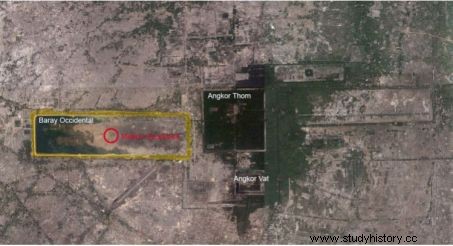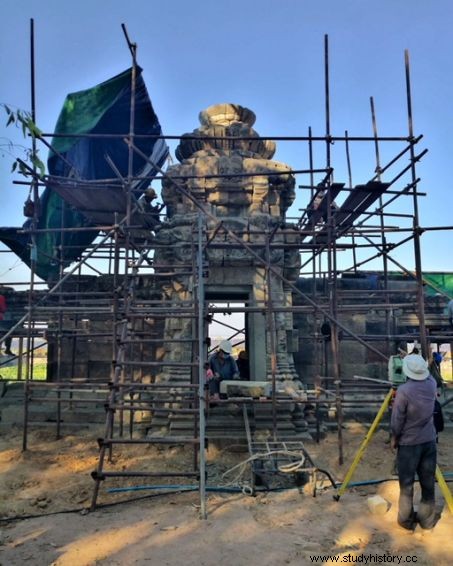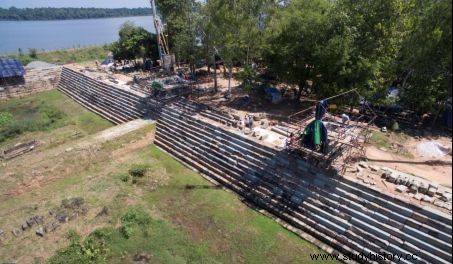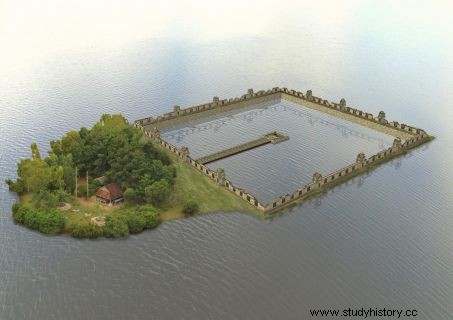Between sky and water, on the site of Angkor, the former capital of the Khmer Empire (9 th -XV e century), a Franco-Cambodian team brings life back to Mebon, an 11th century temple century.
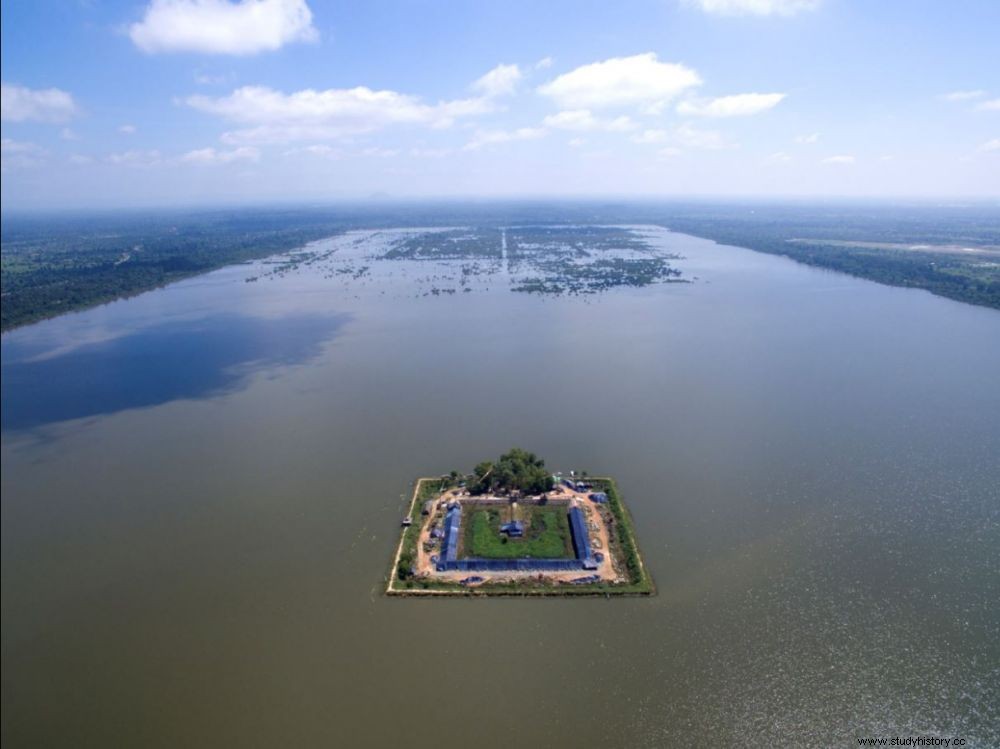
The Mebon temple in the heart of the artificial West Baray basin in Angkor, Cambodia.
The sacred shrine seems to float on the water. Located on a mound in the center of the Western Baray artificial reservoir dug by hand in the 11th century century - the largest in Asia with 8km long and 2.3km wide - the temple of Mebon surrounds itself an interior basin. This religious building of 100m side, which belongs to the famous archaeological complex of Angkor (Cambodia), is being rescued by French teams. The mission was indeed entrusted to the French School of the Far East (EFEO) in cooperation with the Authority for the Protection of the Site and the Development of the Angkor Region (APSARA). This rescue of the Mebon is a real challenge.
Satellite image of the Angkor Archaeological Park (Cambodia) with the location of the West Mebon artificial basin. ©EFEO
It follows the impressive rehabilitation, by the prestigious French institution, of the temple-mountain of Baphuon, considerable work carried out over fifteen years by the archaeologist of the EFEO Pascal Royère, who died in 2014, which reported Sciences and Future (No. 733). Maric Beaufeïst, a French heritage architect met on site in December 2017 by Sciences et Avenir, is taking part in this new challenge. The water is indeed everywhere, including in the ground where it constantly tries to attack the artificial dike built by APSARA and which allows work to be carried out during the flood periods from September to April. In addition, hardly anything remained of the superstructure of the temple, built in the 11th century. century, apart from a few of the twelve pavilions, sort of openwork and sculpted towers.
One of the twelve sculpted pavilions of the Mebon temple, currently being restored. © Barbara Holtzmann /Bernadette Arnaud
Renovated for the first time in 1944 - but only in its visible parts and without interventions on the foundations - this sacred building had not stood the test of time and was again in danger of collapsing. The decision was then taken to consolidate the structures, with the desire to rehabilitate this archaeological site to restore it to its full glory. Because at the heart of its central basin, which is accessed by taking an elevated causeway, once stood the statue of one of the most important deities of the Hindu trinity with Brahma and Shiva, that of a colossal Vishnu lying in bronze! (read box ). “This site is unique, explains Christophe Pottier, architect of the EFEO, also present on site.It is linked to a real staging of the ritualization of water, a less well-known part of Angkor, less monumental but just as important .
To definitively consolidate the temple built on sand foundations, the archaeologists had to dismantle the myriads of sandstone blocks constituting the steps to install; at the back, a solid mass of "reinforced earth". This technique consists of reinforcing the existing floors by enclosing them in geotextile (polyethylene) mesh mattresses, before placing the cut sandstone courses, pavilions and perimeter walls above them.
Construction in progress of the temple of Mebon, with the restoration of one of the surrounding walls. © EFEO
"It's a restoration that makes you humble, because most of the work is located under the stone wall, in the bowels of the monument, and therefore invisible to the eye naked", explains Maric Beaufeïst. Thus, every morning, assisted for two years by Marc Grillo, site manager, she finds a hundred workers and stonemasons on the banks of the body of water so that they can borrow together the motorboats allowing them to reach the temple-islet.
Projected view of the Mébon as it will be after restoration. © Image S. Leuckx / M.-C. Beaufeïst
"Working on a construction site where you have such difficult access does not simplify things" , says Yves Goudineau, director of the French School of the Far East (EFEO). Everything must indeed be transported from the shore (sand, stones, equipment), to then be stored in the reduced space of the temple where the blocks in the reassembly phase are already concentrated. The completion of this archaeological site, one of the largest currently being carried out by France, is scheduled for 2019.
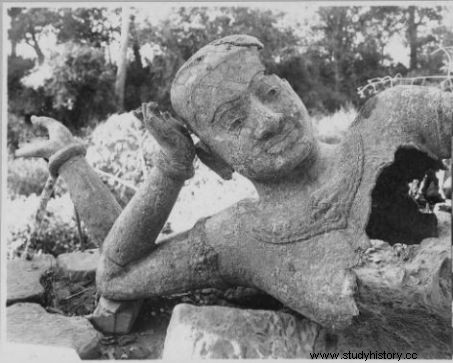
Elements of the statue of the great reclining Vishnu at the time of his discovery in 1936. © EFEO
The statue of Vishnu
It was in 1936 that the curator of Angkor, Maurice Glaize, discovered the major piece of the temple of Mebon during the first campaigns on the famous Cambodian site then eaten away by vegetation:a colossal statue of a large Vishnu reclining in bronze. Parts of this work, which was originally 4m long, are now on display at the National Museum in Phnom Penh, the capital of Cambodia. Bronze pipes, unearthed during the work, also suggest that a jet of water escaped from the body of the Indian deity. Moreover, remains of what could have been a linga , a phallic-looking stone embodying the god Shiva, also seem to have been excavated.

